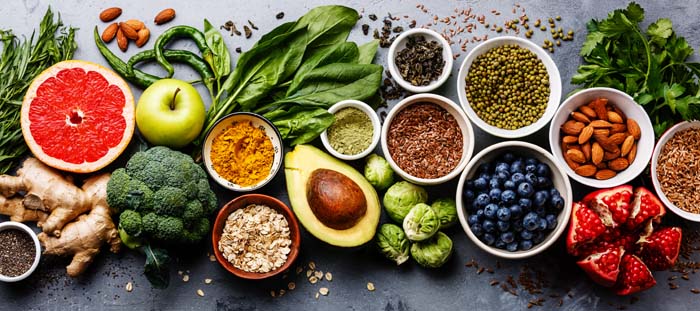Every day we ingest millions of microbes from the food we eat. Many foods contain hundreds of microbial species with millions of bacteria. There are about a thousand species of bacteria in some spice mixes. Hundreds of species in cucumbers and kimchi. One apple can contain about 100 million bacteria!
This raises the question of how many microbes are we ingesting from food each day, and are all these microbes beneficial or causing us harm?
What is the gut microbiome?
It turns out that the wide assortment and large numbers of microbes in foods are very important for good health and a healthy gut microbiome.
The gut microbiome or microbiota is the huge community of bacteria, fungi, and viruses that live in our intestines. The intestines are packed with trillions of these microbes, and it is estimated that about 500 to 1000 different species of bacteria live in the human gut. All these microbes are important for proper immune system function, for getting nutrients from foods, protecting us from harmful microbes (pathogens), and metabolic health.

Foods contain both beneficial and harmful bacteria existing together
For years food microbe research focused on harmful bacteria and other disease-causing microbes that can occur on foods if they spoil or are not properly handled. This is because harmful microbes (e.g., E. coli, Listeria, Shigella, and Salmonella) have resulted in serious illnesses, disease outbreaks, and even deaths. Studies looked at how to prevent spoilage and the growth of pathogenic bacteria.
This changed in the early 2000s when new technology (e.g., genetic sequencing) was developed, which led to researchers discovering a microbial world in and on food. They found a wide variety of microbes occurring naturally in all sorts of foods, including produce, fermented foods, and meat. Hundreds of species of beneficial, benign, and even some harmful or spoilage bacteria were all found to be existing together on foods.
A surprising finding was that spoilage or harmful microbes are usually found on foods at low levels. They are typically kept in check by other beneficial or benign microbes unless something happens to cause them to multiply. Or they can be introduced to the food from contamination at some point (e.g. Listeria in cheese).
Researchers found that each type of food has a different and unique assortment of microbes on and in them – which they call a core microbiome. Of the hundreds of different species of bacteria on foods, most are considered beneficial or harmless.

How many microbes do we eat each day?
There is huge variation in how many microbes we ingest each day, and it depends on the types of foods a person eats.
A study by University of California researchers in 2014 asked the basic question of how many microbes the average American adult consumes daily from food and beverages. The researchers analyzed meals representing three typical dietary patterns of Americans: 1) the average American diet (lots of convenience foods), 2) the US government recommended diet (emphasis on fruits and vegetables, lean meat, dairy, and whole grains), and 3) vegan diet (excludes all animal and dairy products). They found that Americans likely consume in the range of 1 million to 1 billion live microbes each day. Since they are alive, they can possibly multiply in the gut (this is referred to as CFUs or colony forming units).
The highest numbers (3-fold higher) of microbes were in the US government recommended meal plan, in which 2 meals each day included a serving of fermented foods. The fermented foods had not been heat-treated or pasteurized (these treatments kill many bacteria).
When we eat foods, we are ingesting the millions of microbes in the foods. While some microbes join our established gut microbial community, many other microbes just pass through our gut and then leave the body in our stools. Researchers call the passing through microbes the transient microbiome. It appears that microbes can have a beneficial effect even as they are passing through.
The microbial communities are different for each food
Many foods have been analyzed to see what microbes they contain. Foods that have been analyzed typically have hundreds of different microbial species, and some foods thousands (e.g., fish). The numbers of bacteria on foods can vary from low amounts to millions of bacteria (e.g., apples). Fresh fruits and vegetables typically contain high amounts of bacteria.
Foods known to have hundreds of species of bacteria include cheese, fruits and vegetables, fish, meat (beef, pig, chicken), pine nuts, sesame seeds, cilantro, masala spice mixes, smoked salmon, mung bean sprouts, milk, sauerkraut, and kimchi.
Many factors influence what microbes are found in the food, such as where and how the food was farmed or prepared, and whether the food is organic or non-organic. Some foods are heat-treated to kill microbes, which may kill many microbes, but not all. For example, there are differences in the variety and numbers of bacteria when comparing raw milk, pasteurized milk, and ultra-pasteurized milk.
Fermented foods contain hundreds of microbial species, which change over the course of fermentation. Microbes can come from the raw ingredients (e.g., the vegetables in kimchi) or it can come from starter cultures that were added to make foods (e.g., yogurt, cheese). There are numerous fermented foods, including dairy products (e.g., cheese, cultured buttermilk, sour cream, yogurt, and kefir), traditional sausages, fermented vegetables, kimchi, sauerkraut, miso, and natto.
Eating more microbes is good for the gut microbiome
One important research finding in the last two decades is that a greater diversity or variety of bacterial species in the gut is a sign of health. More species is better. A way to achieve this is by frequently eating foods containing high numbers of microbes, such as fresh produce and fermented foods.
Some researchers have even suggested that, just like with vitamins, that there should be a minimum daily requirement of microbes in your diet every day.
Exciting research published this year found that eating fermented foods, which are naturally rich in many beneficial microbial species, can quickly improve the gut microbiome.
In the study by Stanford Univ. of Medicine researchers, 36 healthy adults were randomly assigned to a 10 week diet that was rich in either high-fiber foods or fermented foods. The two diets resulted in different effects on the gut microbiome and the immune system. Eating fermented foods for 10 weeks reduced inflammation and increased the diversity of gut microbes.
The fermented foods group ate six servings daily (e.g. yogurt, kefir, fermented cottage cheese, kimchi, sauerkraut, traditional dill pickles, and kombucha tea). Serving size was typically 1/2 cup. The high fiber group increased their fiber intake from about 22 grams per day to 45 grams, by eating a diet rich in legumes, seeds, whole grains, nuts, vegetables, and fruits.
BOTTOM LINE: You are what you eat.
We ingest millions of bacteria with the foods we eat and this has health benefits. Some of the microbes in the foods may join our resident gut microbes, while others may just pass through. But all have an effect.
The evidence is clear that eating high numbers of microbes from a variety of foods is good for the gut microbiome and health. To increase the numbers of beneficial microbes in your gut, eat a diet rich in fruits, vegetables, whole grains, nuts, and legumes, as well as some fermented foods.
This will support a gut microbiome with a diversity of species (a sign of health!), lower levels of inflammation, and a lower risk of many chronic diseases, such as diabetes.
You are what you eat.



Leave a comment: